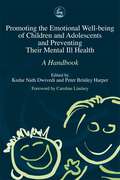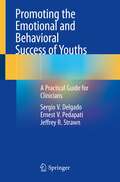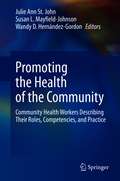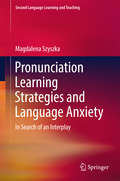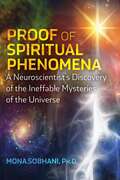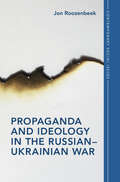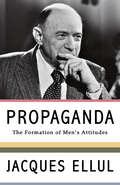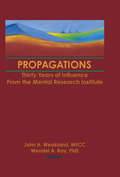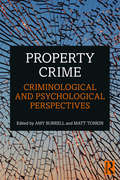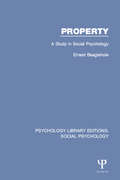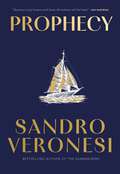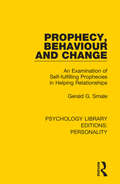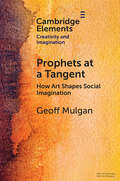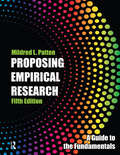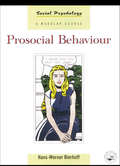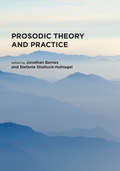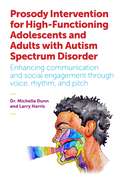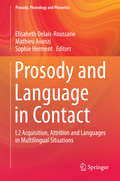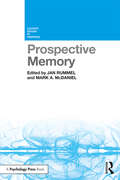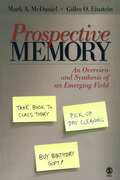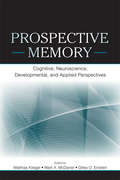- Table View
- List View
Promoting Young Children's Emotional Health and Wellbeing: A Practical Guide for Professionals and Parents
by Sonia Mainstone-CottonPositive emotional health in a child's earliest years can be a critical factor in their future development. Offering practical suggestions for games, activities and exercises designed to promote emotional wellbeing in young children, this essential guide showcases a wide range of approaches such as mindfulness and meditation, Forest School and Reggio Emilia to provide a hands-on reference for teachers and parents. Drawing on over 25 years' experience as an early years professional, the author explores topics including playfulness, stillness, sensory play, creativity and staff wellbeing. Each topic references current best practices and international examples, and also includes a comprehensive list of further resources and activities. Providing an informative introduction to both theory and practice, this book demonstrates easy-to-implement ideas for any professional or parent engaging with young children.
Promoting Youth Sexual Health: Home, School, and Community Collaboration
by Gina Coffee Pamela Fenning Tommy L. WellsPromoting Youth Sexual Health, written for preventionists and interventionists who work with children and adolescents across home, school, or community settings, offers guidance on how to promote sexual health among youth. The reader is first introduced to the state of the field, including sexual behaviors in which youth engage, sexual risk and protective factors, standards and professional guidelines for promoting sexual health of youth, developmental and cultural considerations, and considerations in supporting LGBTQ youth. Evidence-based strategies to support child and adolescent sexual health in homes, schools, and communities are then presented. The book concludes with a proposed model for integrating supports across settings to comprehensively promote youth sexual health.
Promoting the Emotional Well Being of Children and Adolescents and Preventing Their Mental Ill Health: A Handbook
by Kedar Nath Dwivedi Peter Harper Panos VostanisThis comprehensive guide provides overviews of the key psychological processes affecting mental health, such as development, attachment, emotion regulation and attention, and draws out the implications for preventive measures and promotion of emotional well-being. The authors, from a range of professional disciplines, emphasise the importance of early intervention and prevention, exploring in particular how initiatives in parenting and education can promote children's emotional well-being. The topics they cover include: * the prevention and management of addiction and eating disorders * the development of culturally sensitive services for ethnic minority children and families * the impact of parenting programmes and the life skills education programmes in schools * ways of meeting the mental health needs of children who are socially excluded, homeless or in local authority care. Providing examples of a broad range of projects and initiatives in Britain and other European countries, this handbook will be an invaluable resource for all professionals working in child and adolescent mental health.
Promoting the Emotional and Behavioral Success of Youths: A Practical Guide for Clinicians
by Sergio V. Delgado Jeffrey R. Strawn Ernest V. PedapatiClinicians often have difficulty helping the parents of youth with emotional and behavioral difficulties and fail to recognize that often it is the youth’s cognitive and learning weaknesses that drive their maladaptive behaviors. This book aims to help clinicians further understand the roots of youth’s maladaptive behaviors. It also addresses the impact of youth’s varied cognitive abilities on their behaviors and problems with self-esteem, particularly in youth that do not meet the diagnostic criteria for a formal learning disability. While many clinicians view learning deficits as impairments in specific academic skills, these deficits go beyond varied learning abilities and often experience difficulties in emotional, social, and behavioral functioning. These impairments vary from child to child and it is crucial to develop practical interventions for improved self-esteem and emotional success. Varied learning abilities reflect a neurodevelopmental problem in youth that can lead to difficulties with their emotional, social, and academic functioning and limit their intellectual potential. There are often treatment impasses when a youth’s behavioral problems do not improve with traditional forms of psychotherapy and medication. The practical individualized interventions recommended in this book will: 1) decrease conflict in day-to-day interactions between youth and parents, 2) improve self-esteem and 3) help to achieve realistic social, emotional and academic goals. The text will help clinicians determine which maladaptive behaviors are a result of cognitive deficits and not “symptoms” of a disease-based mental disorder.Written by experts in the field, Promoting the Emotional and Behavioral Success of Youths reviews appropriate interventions in the context of the public health strategies that address the prevention of secondary socio-economic aspects as a result of cognitive weaknesses, such as realistic educational needs, career and employment choices. Clinicians will be able to use this book to develop “best fit” multimodal interventions to help parents of youth develop adaptive behaviors.
Promoting the Health of the Community: Community Health Workers Describing Their Roles, Competencies, and Practice
by Julie Ann St. John Susan L. Mayfield-Johnson Wandy D. Hernández-GordonCommunity health workers (CHWs) are an increasingly important member of the healthcare and public health professions who help build primary care capacity. Yet, in spite of the exponential growth of CHW interventions, CHW training programs, and CHW certification and credentialing by state agencies, a gap persists in the literature regarding current CHW roles and skills, scope of practice, CHW job settings, and national standards. This collection of contributions addresses this gap by providing information, in a single volume, about CHWs, the roles CHWs play as change agents in their communities, integration of CHWs into healthcare teams, and support and recognition of the CHW profession. The book supports the CHW definition as defined by the American Public Health Association (APHA), Community Health Worker Section (2013), which states, “A community health worker is a frontline public health worker who is a trusted member of and/or has an unusually close understanding of the community served.” The scope of the text follows the framework of the nationally recognized roles of CHWs that came out of a national consensus-building project called “The Community Health Worker (CHW) Core Consensus (C3) Project”. Topics explored among the chapters include:Cultural Mediation Among Individuals, Communities, and Health and Social Service SystemsCare Coordination, Case Management, and System NavigationAdvocating for Individuals and CommunitiesBuilding Individual and Community CapacityImplementing Individual and Community AssessmentsParticipating in Evaluation and ResearchUniting the Workforce: Building Capacity for a National Association of Community Health WorkersPromoting the Health of the Community is a must-have resource for CHWs, those interested in CHW scope of practice and/or certification/credentialing, anyone interested in becoming a CHW, policy-makers, CHW payer systems, CHW supervisors, CHW employers, CHW instructors/trainers, CHW advocates/supporters, and communities served by CHWs.
Pronunciation Learning Strategies and Language Anxiety
by Magdalena SzyszkaThis book presents theoretical considerations and the results of empirical research on pronunciation learning strategies (PLS) deployed by pre-service trainee teachers majoring in English as a foreign language who experienced different levels of language anxiety (LA). The theoretical part focuses on the concepts of pronunciation learning, pronunciation-learning strategies and language anxiety and includes an overview of recent empirical research dealing with various related issues. The empirical section of the book presents the findings of a research project that investigated the interplay between PLS and LA, in which both quantitative and qualitative data were collected. Based on the findings, the author proposes two profiles of anxious and non-anxious EFL trainee teachers who support their pronunciation learning with an array of pronunciation learning strategies and tactics.
Proof of Spiritual Phenomena: A Neuroscientist's Discovery of the Ineffable Mysteries of the Universe
by Mona Sobhani• Shares data and meta-analysis from a large volume of extremely sophisticated experiments that provide proof for the existence of psi phenomena • Explores evidence of past lives, intuitive knowing, and other spiritual phenomena • Reveals the author&’s own inexplicable experiences as well as her conversations with scientific colleagues, high-level experts, and government officials Fully indoctrinated into the cult of science, neuroscientist Mona Sobhani, Ph.D., aggressively defended the dogma of scientific beliefs--until a series of life-altering events caused her to reconsider spirituality and psi concepts and launched her into a two-year investigation into the ineffable mysteries of our world. Sharing the extensive research she discovered on past lives, karma, and the complex interactions of mind and matter, the author details her transformation from diehard materialist to open-minded spiritual seeker. She reveals her conversations about spirituality and anomalous occurrences with scientific colleagues as well as high-level experts and government officials who shared data on extremely sophisticated experiments that provided proof for the existence of psi phenomena. She discovered that psi research has been conducted on a grand scale for more than a century--by hundreds of scientists with hundreds of thousands of participants--and that there exists substantial evidence for the reality of psi. She examines meta-analysis of these experiments, such as that of the Ganzfield tests, which showed odds against chance of 12 billion to 1--throwing our current scientific materialist paradigm into question. Providing a deep dive into the literature of psychology, quantum physics, neuroscience, philosophy, and esoteric texts, Sobhani also explores the relationship between psi phenomena, the transcendence of space and time, and spirituality. Culminating with the author&’s serious reckoning with one of the foundational principles of neuroscience--scientific materialism--this illuminating book shows that the mysteries of human experience go far beyond what the present scientific paradigm can comprehend.
Propaganda and Ideology in the Russian–Ukrainian War (Contemporary Social Issues Series)
by Jon RoozenbeekRussia's invasion of Ukraine is one of the most important conflicts of the twenty-first century. With the start of military hostilities in 2014 also came an onslaught of propaganda, to both convince and confuse audiences worldwide about the war's historical and ideological underpinnings. Based on extensive research drawing on tens of thousands of news articles and hundreds of pages of legal documents and internal correspondence, this book offers the first comprehensive analysis of the role of propaganda, ideology, and identity in the Russian-Ukrainian war. It argues that, despite Russia's efforts to set up a media machine at home and abroad with eight years of propaganda legitimising Russia's presence in eastern Ukraine, Russia failed to vocalise a convincing alternative to Ukrainian nationhood. Instead, Russian propaganda backfired: Ukraine is now more united than ever before.
Propaganda: The Formation of Men's Attitudes
by Jacques EllulThis seminal study and critique of propaganda from one of the greatest French philosophers of the 20th century is as relevant today as when it was first published in 1962. Taking not only a psychological approach, but a sociological approach as well, Ellul&’s book outlines the taxonomy for propaganda, and ultimately, it&’s destructive nature towards democracy. Drawing from his own experiences fighting for the French resistance against the Vichy regime, Ellul offers a unique insight into the propaganda machine.
Propagations: Thirty Years of Influence From the Mental Research Institute
by Terry S TrepperHere is a work of profound clinical scope from some of the foremost leaders in psychology. Propagations: Thirty Years of Influence From the Mental Research Institute, written by alumni and disciples of the Institute (MRI), is not just a compliment to the MRI influence, but also a way for readers to discover and savor the important contributions of those influenced by the MRI. The book contains the cutting edge thinking of some of the most respected clinicians from across the globe. The authors describe their application of ideas pioneered at the MRI, demonstrating its broad influence on present day leaders of family and brief therapy. Chapters range from the theoretical to the case study, tied together by the theme of how this amazing institute has widely impacted therapeutic thought. The book clarifies the depth and power of the MRI influence, which extends to theory, all aspects of psychotherapy practice, other professions, and other lands. Propagations offers outstanding conceptualizations, teaching, writing, and clinical and non-clinical therapy ideas that are immediately useful to clinicians, academic researchers, students, and other individuals interested in how people change.The book’s introduction provides background information on MRI and includes a condensed transcript of a “trialog” which took place between Jules Riskin, Paul Watzlawick, and John Weakland conveying MRI’s origins, traditions, and ethos. Propagations then breaks into four sections. Influencing Fields of Interest and Viewpoints examines MRI influence beyond the specific field of psychotherapy. Influences on Clinical Work looks at MRI’s influence on professional groups and contains clinicians’reflections on how contact with MRI theory and practice has influenced their work. Changes in Venue shows utilization of MRI approaches across cultural and professional borders, while The Outer Reaches looks beyond the specifics of psychotherapy. This inviting book reflects a wide variety of approaches, styles, and subjects, and ranges from preliminary musings to formal reports. This diversity offers a useful example of how new ideas and related practices develop and diversify from a broad common core. Readers can discover how interactional principles are being implemented in different nations, practice settings, and theoretical applications. Family and brief therapists, counselors and counselor educators, and professionals in related fields will find Propagations a source of useful information, thoughtful recollection, and stimulation for future activities.
Property Crime: Criminological and Psychological Perspectives
by Amy Burrell and Matt TonkinProperty Crime: Criminological and Psychological Perspectives pulls together expertise from a wide range of academics and practitioners who focus on preventing and investigating property crime. From car theft and vandalism to burglary and robbery, this book provides an insight into the motivations and pathways of crime, as well as how it is investigated and what happens to offenders when they are caught. This book aims to highlight the extent, nature, and impact of property crime as well as providing an overview of different topics such as: offender crime scene behaviour, motivations, the decision process that underpins a range of property-related offences, prosecution, rehabilitation, and prevention. In addition, the processes and challenges involved in investigating and prosecuting property offences are discussed from a range of perspectives, including crime analysts, police detectives, forensic crime scene investigators, and prosecutors. This is an essential read for students, applied researchers, and practitioners working across the criminal justice system. It is a 'one-stop-shop' for anyone interested in this pervasive form of criminal behavior.
Property: A Study in Social Psychology (Psychology Library Editions: Social Psychology)
by Ernest BeagleholeFirst published in 1931, this book represents an attempt to study the psychological basis of the institution of property. There had been many psychological and social studies of marriage and religion prior to publication of this title but none which considered the problems which arise when the institution of property is viewed from the angle of social psychology. Some of these problems are set out in the first chapter. In the remaining chapters the author discusses the problems in the light of evidence drawn from the various branches of psychology and sociology of the day. The final chapter indicates the importance of the author’s conclusions for political and social theory at the time.
Prophecy
by Sandro VeronesiFROM THE BESTSELLING AUTHOR OF THE HUMMINGBIRD'The dawn will still be far away, and you will lift your eyes to the sky, and the sky will be as black as sackcloth and ashes'Addressed to a 'you' that encompasses the author, the reader and all of us at once, narrated in the future tense of apocalyptic texts and inspired by Sandro Veronesi's own experience of caring for his elderly parents, Prophecy is a powerful and unforgettable story of immense grief and infinite love.A visionary take on life by one of today's most remarkable writers.PRAISE FOR SANDRO VERONESI'S THE HUMMINGBIRDWinner of the Premio Strega | A Guardian and Spectator Book of the Year'Magnificent'GUARDIAN'A towering achievement'FINANCIAL TIMES'Inventive, bold, unexpected'SUNDAY TIMES'Masterly'IAN MCEWAN'Extraordinary'HOWARD JACOBSON'A real masterpiece'LEILA SLIMANI
Prophecy
by Sandro VeronesiFROM THE BESTSELLING AUTHOR OF THE HUMMINGBIRD'The dawn will still be far away, and you will lift your eyes to the sky, and the sky will be as black as sackcloth and ashes'Addressed to a 'you' that encompasses the author, the reader and all of us at once, narrated in the future tense of apocalyptic texts and inspired by Sandro Veronesi's own experience of caring for his elderly parents, Prophecy is a powerful and unforgettable story of immense grief and infinite love.A visionary take on life by one of today's most remarkable writers.PRAISE FOR SANDRO VERONESI'S THE HUMMINGBIRDWinner of the Premio Strega | A Guardian and Spectator Book of the Year'Magnificent'GUARDIAN'A towering achievement'FINANCIAL TIMES'Inventive, bold, unexpected'SUNDAY TIMES'Masterly'IAN MCEWAN'Extraordinary'HOWARD JACOBSON'A real masterpiece'LEILA SLIMANI
Prophecy, Behaviour and Change: An Examination of Self-fulfilling Prophecies in Helping Relationships (Psychology Library Editions: Personality)
by Gerald G. SmaleProfessional helpers may harm their clients instead of helping them. This is one of the important implications – for the selection, training and practice of members of the helping professions – of the evidence reviewed in this book. Originally published in 1977, Gerald Smale argues that the expectations of the professional helper, whether social worker, doctor, psychiatrist, psychoanalyst, psychotherapist or counsellor, can act as self-fulfilling prophecies on his or her clients, for better or worse. In order to suggest how the expectations of the helper might operate, the author examines a three-stage model of self-fulfilling prophecies. The stages are: the prophecy; behaviour based upon the prophecy; the outcome brought about by the behaviour. Extensive evidence from the fields of experimenter bias, hypnosis and placebo medicine, psychotherapy, casework and counselling research, is reviewed and related to the model, and the relationship between this analysis and labelling theory is discussed. The book demonstrates that it is the behaviour of the worker towards the client which is of crucial importance, and proposes that the client’s future and his or her personal strengths should be an important focus of the helping relationship. Finally, it outlines the dangers of negative expectations, and emphasises the ways in which expectations can be used to optimum effect.
Prophets at a Tangent: How Art Shapes Social Imagination (Elements in Creativity and Imagination)
by Geoff MulganThis Element asks if the arts can help us imagine a better future society and economy, without deep social gulfs or ecological harm. It argues that at their best, the arts open up new ways of seeing and thinking. They can warn and prompt and connect us to a bigger sense of what we could be. But artists have lost their role as gods and prophets, partly as an effect of digital technologies and the ubiquity of artistic production, and partly as an effect of shifting values. Few recent books, films, artworks or exhibitions have helped us imagine how our world could solve its problems or how it might be better a generation or more from now. This Element argues that artists work best not as prophets of a new society but rather as 'prophets at a tangent'.
Proposing Empirical Research: A Guide to the Fundamentals
by Mildred L Patten• Provides step-by-step instructions for students who will be writing their first research proposal in the social and behavioral sciences. • Each major section is divided into short topics. For each topic, students complete an exercise that leads them toward the goal of preparing a proposal. • Numerous examples throughout the book make the recommendations for proposal writing come alive. • The model proposals at the end of the book illustrate proposal writing and provide material for classroom discussions. • Provides concrete guidance for students who will be writing proposals for both quantitative and qualitative research. • The structure of this book enables students to work independently with confidence while writing the first drafts of their proposals. • All steps in proposal writing are clearly described and illustrated. • Ideal for use in: · research methods classes where students write a proposal as a term project, · thesis/dissertation preparation classes, · senior research seminars where proposing and conducting research is a culminating undergraduate activity, and · any graduate-level seminar in which the instructor wants to incorporate a project that will engage students in critical thinking about the content area. • Written by our best-selling author, Mildred L. Patten. Your students will appreciate her clear and informative style.
Prosocial Behaviour
by Hans-Werner BierhoffHow can social bonds in society be strengthened? How do we learn and develop prosocial behaviour? This comprehensive textbook provides up-to-date coverage of the social phenomenon of prosocial behaviour, incorporating all the major developments in the fields of developmental and social psychology. The first section identifies different forms of prosocial behaviour, including estimates of prevalence in everyday situations and the controversy between biological and cultural perspectives as explanatory models of prosocial behaviour. The second and third sections focus on learning and development, with emphasis on social learning, responsibility, empathy and guilt. The fourth section explores the prevalence of prosocial behaviour, in particular the situational and personality factors which inhibit urgently needed prosocial behaviour. The final section is devoted to practical applications, such as how to increase the likelihood that people will work as volunteers in community organisations and how to heighten the willingness to offer first aid. This book will be an invaluable resource for both undergraduate and postgraduate students of social psychology and sociology, as well as anyone with an interest in social services and voluntary organisations.
Prosodic Theory and Practice
by Jonathan Barnes and Stefanie Shattuck-HufnagelAn introduction to the the range of current theoretical approaches to the prosody of spoken utterances, with practical applications of those theories.Prosody is an extremely dynamic field, with a rapid pace of theoretical development and a steady expansion of its influence beyond linguistics into such areas as cognitive psychology, neuroscience, computer science, speech technology, and even the medical profession. This book provides a set of concise and accessible introductions to each major theoretical approach to prosody, describing its structure and implementation and its central goals and assumptions as well as its strengths and weaknesses. Most surveys of basic questions in prosody are written from the perspective of a single theoretical framework. This volume offers the only summary of the full range of current theoretical approaches, with practical applications of each theory and critical commentary on selected chapters. The current abundance of theoretical approaches has sometimes led to apparent conflicts that may stem more from terminological differences, or from differing notions of what theories of prosody are meant to achieve, than from actual conceptual disagreement. This volume confronts this pervasive problem head on, by having each chapter address a common set of questions on phonology, meaning, phonetics, typology, psychological status, and transcription. Commentary is added as counterpoint to some chapters, with responses by the chapter authors, giving a taste of current debate in the field. ContributorsAmalia Arvaniti, Jonathan Barnes, Mara Breen, Laura C. Dilley, Grzegorz Dogil, Martine Grice, Nina Grønnum, Daniel Hirst, Sun-Ah Jun, Jelena Krivokapić, D. Robert Ladd, Fang Liu, Piet Mertens, Bernd Möbius, Gregor Möhler, Oliver Niebuhr, Francis Nolan, Janet B. Pierrehumbert, Santitham Prom-on, Antje Schweitzer, Stefanie Shattuck-Hufnagel, A. E. Turk, Yi Xu
Prosody Intervention for High-Functioning Adolescents and Adults with Autism Spectrum Disorder: Enhancing communication and social engagement through voice, rhythm, and pitch
by Michelle Dunn Larry Harris Julia DunnProviding lessons for prosody intervention in high-functioning adolescents and young adults with Autism Spectrum Disorder (ASD), this book helps to develop verbal and nonverbal skills to aid their transition into adulthood through a program of evidence-based lessons and resources. The authors offer a complete curriculum of lessons taking student from self-calming to fluency and conversational skills and thereby enhancing their communication skills and conversational competence, skills that are essential for the ability to get on in adult life, for example in the context of looking for a job. The curriculum includes lesson plans, handouts and homework, and builds on some of the characteristic traits of high-functioning autism, for example by setting up sets of rules for clarity. The program has been successfully used by the authors in their work with people on the autism spectrum and will be a life-changing resource for professionals as well as for parents and people on the autism spectrum wanting to improve their ability to communicate well.
Prosody and Language in Contact
by Elisabeth Delais-Roussarie Mathieu Avanzi Sophie HermentThis volume provides new insights into various issues on prosody in contact situations, contact referring here to the L2 acquisition process as well as to situations where two language systems may co-exist. A wide array of phenomena are dealt with (prosodic description of linguistic systems in contact situations, analysis of prosodic changes, language development processes, etc. ), and the results obtained may give an indication of what is more or less stable in phonological and prosodic systems. In addition, the selected papers clearly show how languages may have influenced or may have been influenced by other language varieties (in multilingual situations where different languages are in constant contact with one another, but also in the process of L2 acquisition). Unlike previous volumes on related topics, which focus in general either on L2 acquisition or on the description and analyses of different varieties of a given language, this volume considers both topics in parallel, allowing comparison and discussion of the results, which may shed new light on more far-reaching theoretical questions such as the role of markedness in prosody and the causes of prosodic changes.
Prospect Theory
by Peter P. WakkerProspect Theory: For Risk and Ambiguity provides the first comprehensive and accessible textbook treatment of the way decisions are made both when we have the statistical probabilities associated with uncertain future events (risk) and when we lack them (ambiguity). The book presents models, primarily prospect theory, that are both tractable and psychologically realistic. A method of presentation is chosen that makes the empirical meaning of each theoretical model completely transparent. Prospect theory has many applications in a wide variety of disciplines. The material in the book has been carefully organized to allow readers to select pathways through the book relevant to their own interests. With numerous exercises and worked examples, the book is ideally suited to the needs of students taking courses in decision theory in economics, mathematics, finance, psychology, management science, health, computer science, Bayesian statistics, and engineering.
Prospective Memory (Current Issues in Memory)
by Jan Rummel Mark A. McDanielFeaturing contributions from world-leading experts, this book presents a timely overview of current theoretical, methodological, and applied issues in the field of prospective memory. The authors explore how prospective memories are formed, how they are maintained over time, and how they are retrieved. This volume integrates our understanding of prospective memory and how it functions with related cognitive processes and themes, such as context memory, metamemory, working memory, and cognitive control. Considering recent methodological advances in the field, such as the use of cognitive modeling, the book also covers individual differences in prospective memory abilities, their development across the life span, and their manifestations in naturalistic settings. The book also illustrates how the understanding of prospective memory can be integrated with other related research areas. Prospective Memory is an invaluable resource for students and researchers of human memory.
Prospective Memory: An Overview and Synthesis of an Emerging Field
by Dr Mark A. Mcdaniel Dr Gilles O. EinsteinWhile there are many books on retrospective memory, or remembering past events, Prospective Memory: An Overview and Synthesis of an Emerging Field is the first authored text to provide a straightforward and integrated foundation to the scientific study of memory for actions to be performed in the future. Authors Mark A. McDaniel and Gilles O. Einstein present an accessible overview and synthesis of the theoretical and empirical work in this emerging field.
Prospective Memory: Cognitive, Neuroscience, Developmental, and Applied Perspectives (Routledge Studies In Nineteenth Century Literature Ser. #5)
by Susan L. RobersonOver the last decade, the topic of prospective memory � the encoding, storage and delayed retrieval of intended actions � has attracted much interest, and this is reflected in a rapidly growing body of literature: 350 scientific articles have been published on this topic since the appearance of the first edited book in 1996. In addition to the quan


